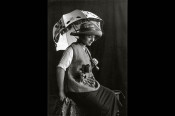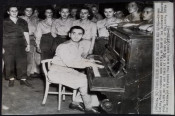Today’s Wonder of the Day was inspired by Brandon from Oshawa. Brandon Wonders, “How does Crystal Glass produce certain tones when rubbed on top with water?” Thanks for WONDERing with us, Brandon!
Do you love music? Whether your tastes lean toward rap, hip hop, country, pop, rock, jazz, or classical, there's surely a musical style that delights your ears on a regular basis. Some people love music so much that listening to it isn't enough. They yearn to play it, too.
Most kids learn early on that you don't need a piano or guitar to make music. There are all sorts of objects around you that can be used to play a tune. If you've ever used spoons against a tabletop or a bucket, you know it's possible to make many different types of things into an impromptu set of drums.
You can also make music with a glass or plastic soda bottle. Have you ever removed the cap and blown a stream of air across the top of a soda bottle? If so, you know it'll produce a deep tone that can sound almost like a foghorn.
Soda bottles aren't the only glass items that can make music. Have you ever poured a glass of water and then dipped your finger in the water and rubbed it around the edge of the glass? When you do this, it produces a tone that can vary in pitch depending upon the type and thickness of glass and the amount of water in it.
How do glasses make music in this way? Is it magic? Nope! The musical effect of glasses stems from a phenomenon known as resonance.
Water glasses, especially pure crystal glasses, have a natural frequency at which they will vibrate. When you rub the rim of the glass, your finger causes additional vibrations. When these vibrations match the natural frequency of the glass, the vibrations can increase to the point where you can hear a tone.
The particular tone produced will vary depending upon many different factors, including the quality of the glass, its thickness, and how much, if any, water is in the glass. In fact, different tones can be produced by putting different amounts of water into several different glasses.
Although you won't find modern musicians breaking out a set of crystal glasses at a concert, glass bowls and goblets were popular for music-making for a brief time long ago. The phenomenon of resonance was written about by Galileo and people have been creating musical notes with glasses since the Renaissance. In fact, sets of glasses produced specifically to play music were popular in England in the early 1700s.
In the early 1760s, Benjamin Franklin began dabbling in glass instruments after seeing a performance on water glasses in London. He invented a mechanical version of a set of water glasses that he at first called the "glassychord." He eventually changed the name to the armonica.
His instrument was also known as the glass harmonica, and it became popular in Europe, especially Germany. Although its popularity didn't last, the armonica did make an impression on both Mozart and Beethoven, who each wrote pieces for the armonica.


.jpg)









Aden
Omar Ansari
Alexa
shaavacadoo2 roblox
Victoria
Ihascupquake
wyvernkid_93
Aliceinwonderland#34569
Aliceinwonderland#34569
ricky
Aliceinwonderland#34569
Julian Aguirre
Aliceinwonderland#34569
Jacob
Aliceinwonderland#34569
Dakota
Aliceinwonderland#34569
makenna (mrs. thompsons class...
Isa
Glass guy
Kaitlyn
Anna R
Aliceinwonderland#34569